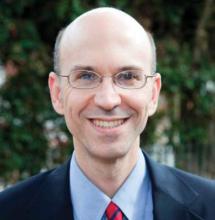SAN FRANCISCO – One year of treatment with delayed-release cysteamine bitartrate was safe and associated with substantial and rapid improvements in liver enzymes in children with nonalcoholic fatty liver disease, but did not improve liver histology.
That finding emerged from the randomized, placebo-controlled phase IIb Cysteamine Bitartrate Delayed-Release for the Treatment of Nonalcoholic Fatty Liver Disease trial (CyNCh).
The rate of histologic improvement in 88 children with nonalcoholic fatty liver disease (NAFLD) who received twice-daily oral delayed-release cysteamine bitartrate (CyB) in the trial was 28%, compared with 22% in 81 children who received placebo (relative improvement ratio, 1.3). An intent-to-treat analysis showed no significant difference between CyB and placebo with respect to initial vs. end-of-treatment improvement in steatosis (30% vs. 41%), ballooning (19% vs. 26%), lobular inflammation (36% vs. 21%), or fibrosis (28% vs. 28%), Dr. Jeffrey B. Schwimmer of the University of California, San Diego, said at the annual meeting of the American Association for the Study of Liver Diseases.
CyB was, however, associated with greater mean change in alanine aminotransferase (–53 vs. –8 U/L) and aspartate aminotransferase (–31 vs. –4 U/L), compared with placebo, he noted, adding that the reduction in aminotransferases with CyB occurred within 4 weeks and was sustained through 52 weeks of treatment.
No changes were seen in serum lipids, cholesterol, or insulin sensitivity, and there were no differences in adverse events with CyB vs. placebo.
NAFLD is the most common cause of chronic liver disease in children, yet there is no approved treatment for the disease in this population, Dr. Schwimmer said.
The current study was initiated based on preliminary evidence showing decreased alanine aminotransferase and aspartate aminotransferase, and increased adiponectin in children treated with cysteamine in a 6-month pilot study. Subjects were children aged 8-17 years from June 2012 to August 2015 with an NAFLD activity score (NAS) of 4 or less. They were randomized to receive twice daily oral CyB at a dose of 300 mg if weight was 65 kg or less, 375 mg if weight was greater than 65 kg to 80 kg, or 450 mg if weight was greater than 80 kg, or to receive matching placebo. All received standardized lifestyle advice.
Histologic improvement was defined as a decrease in NAS of at least 2 points without worsening of fibrosis.
The lessons learned in CyNCh should guide future clinical trials for pediatric NAFLD, Dr. Schwimmer concluded.
He reported having no disclosures.


